
Question Number 192957 by York12 last updated on 31/May/23
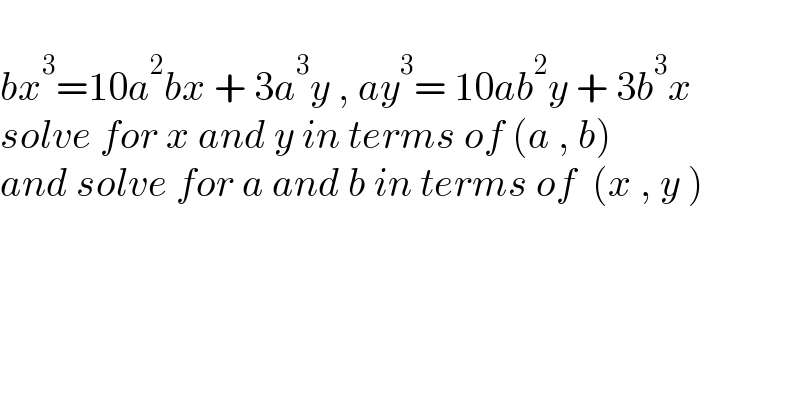
$$ \\ $$$${bx}^{\mathrm{3}} =\mathrm{10}{a}^{\mathrm{2}} {bx}\:+\:\mathrm{3}{a}^{\mathrm{3}} {y}\:,\:{ay}^{\mathrm{3}} =\:\mathrm{10}{ab}^{\mathrm{2}} {y}\:+\:\mathrm{3}{b}^{\mathrm{3}} {x} \\ $$$${solve}\:{for}\:{x}\:{and}\:{y}\:{in}\:{terms}\:{of}\:\left({a}\:,\:{b}\right) \\ $$$${and}\:{solve}\:{for}\:{a}\:{and}\:{b}\:{in}\:{terms}\:{of}\:\:\left({x}\:,\:{y}\:\right) \\ $$
Commented by York12 last updated on 02/Jun/23
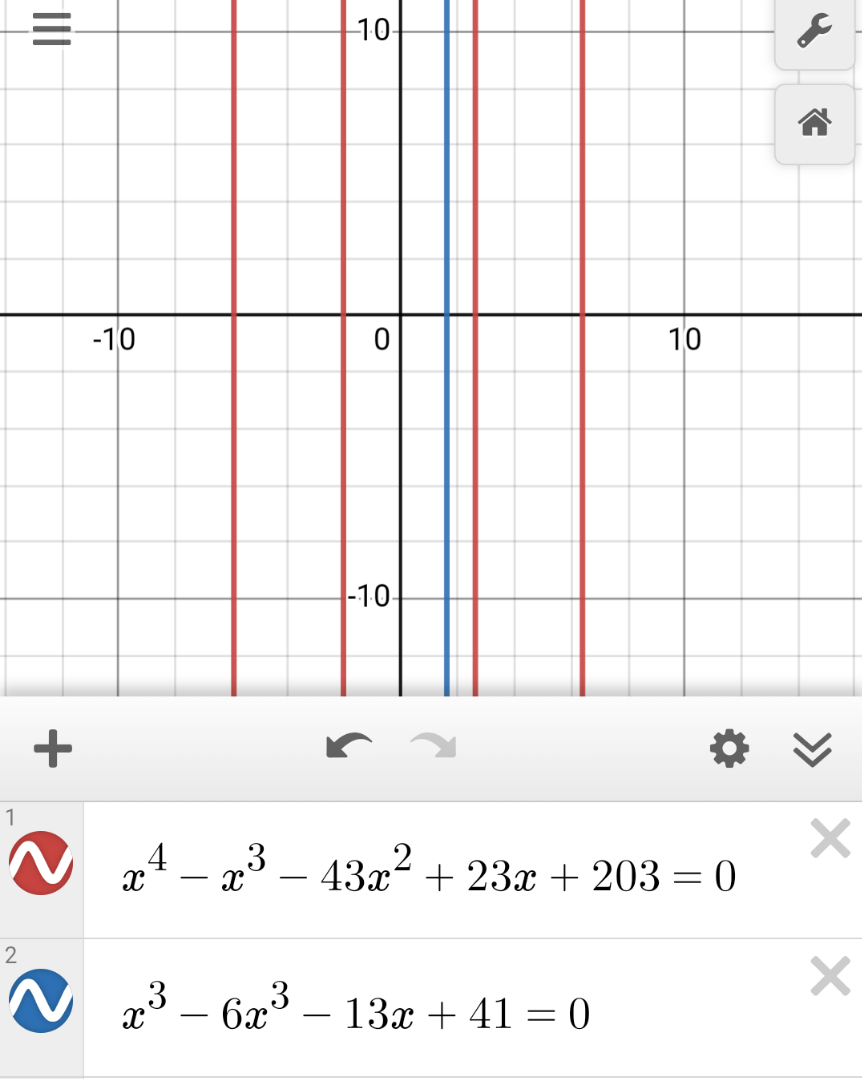
Commented by York12 last updated on 02/Jun/23

$${no}\:{common}\:{roots} \\ $$$${means}\:{no}\:{existence}\:{for}\:{any}\:{value} \\ $$$${of}\:{x}\:{which}\:{can}\:{satify}\:{both}\:{equations} \\ $$$$\Rightarrow\:{your}\:{system}\:{of}\:\:{equations}\:{is}\:{again} \\ $$$${wrong}\: \\ $$
Answered by a.lgnaoui last updated on 01/Jun/23
![{ ((bx^3 −10a^2 bx=3a^3 y⇒ y=((xb(x^2 −10a^2 ))/(3a^3 )) (1))),((3b^3 x=ay^3 −10ab^2 y⇒ x=((ya(y^2 −10b^2 ))/(3b^3 )) (2))) :} y^2 =((x^2 b^2 (x^2 −10a^2 )^2 )/(9a^6 )) x^2 =((y^2 a^2 (y^2 −10b^2 ))/(9b^6 )) (1)⇔y=(b/(3a^3 ))[((ya(y^2 −10b^2 )/(3b^3 ))][(((y^2 a^2 (y^2 −10b^2 )−90a^2 b^6 )/(9b^6 ))] 81a^3 b^9 y=ab(y^2 −10b^2 )(a^2 y^4 −10y^2 a^2 b^2 −90a^2 b^6 ) =a^3 b(y^2 −10b^2 )(y^4 −10y^2 b^2 −90b^6 ) =a^3 b[y^6 −10y^4 b^2 −90y^2 b^6 −10b^2 y^4 +100b^4 y^2 +900b^8 =a^3 b[y^6 −20b^2 y^4 −(90b^6 −100b^4 )y^2 +900b^8 ] =81a^3 b^9 y ⇒81b^8 y=y^6 −20b^2 y^4 −10b^4 (9b^2 −10)y^2 +900b^8 ⇒y^6 −20b^2 [y^4 −(1/2)(9b^2 −10)b^2 y^2 +45b^6 ]−81b^8 y=0 =y^6 −20b^2 (y^2 −(((9b^2 −10)b^2 )/4))^2 −81b^8 y+45b^6 −(((9b^2 −10)b^4 )/(16))=0 ..........to continious](Q192964.png)
$$\begin{cases}{\mathrm{bx}^{\mathrm{3}} −\mathrm{10a}^{\mathrm{2}} \mathrm{bx}=\mathrm{3a}^{\mathrm{3}} \mathrm{y}\Rightarrow\:\:\:\boldsymbol{\mathrm{y}}=\frac{\boldsymbol{\mathrm{xb}}\left(\boldsymbol{\mathrm{x}}^{\mathrm{2}} −\mathrm{10}\boldsymbol{\mathrm{a}}^{\mathrm{2}} \right)}{\mathrm{3}\boldsymbol{\mathrm{a}}^{\mathrm{3}} }\:\left(\mathrm{1}\right)}\\{\mathrm{3b}^{\mathrm{3}} \mathrm{x}=\mathrm{ay}^{\mathrm{3}} −\mathrm{10ab}^{\mathrm{2}} \mathrm{y}\Rightarrow\:\:\boldsymbol{\mathrm{x}}=\frac{\boldsymbol{\mathrm{ya}}\left(\boldsymbol{\mathrm{y}}^{\mathrm{2}} −\mathrm{10}\boldsymbol{\mathrm{b}}^{\mathrm{2}} \right)}{\mathrm{3}\boldsymbol{\mathrm{b}}^{\mathrm{3}} }\:\:\left(\mathrm{2}\right)}\end{cases} \\ $$$$\boldsymbol{\mathrm{y}}^{\mathrm{2}} =\frac{\boldsymbol{\mathrm{x}}^{\mathrm{2}} \boldsymbol{\mathrm{b}}^{\mathrm{2}} \left(\boldsymbol{\mathrm{x}}^{\mathrm{2}} −\mathrm{10}\boldsymbol{\mathrm{a}}^{\mathrm{2}} \right)^{\mathrm{2}} }{\mathrm{9}\boldsymbol{\mathrm{a}}^{\mathrm{6}} } \\ $$$$\boldsymbol{\mathrm{x}}^{\mathrm{2}} =\frac{\boldsymbol{\mathrm{y}}^{\mathrm{2}} \boldsymbol{\mathrm{a}}^{\mathrm{2}} \left(\boldsymbol{\mathrm{y}}^{\mathrm{2}} −\mathrm{10}\boldsymbol{\mathrm{b}}^{\mathrm{2}} \right)}{\mathrm{9}\boldsymbol{\mathrm{b}}^{\mathrm{6}} } \\ $$$$\left(\mathrm{1}\right)\Leftrightarrow\boldsymbol{\mathrm{y}}=\frac{\boldsymbol{\mathrm{b}}}{\mathrm{3}\boldsymbol{\mathrm{a}}^{\mathrm{3}} }\left[\frac{\boldsymbol{\mathrm{ya}}\left(\boldsymbol{\mathrm{y}}^{\mathrm{2}} −\mathrm{10}\boldsymbol{\mathrm{b}}^{\mathrm{2}} \right.}{\mathrm{3}\boldsymbol{\mathrm{b}}^{\mathrm{3}} }\right]\left[\left(\frac{\boldsymbol{\mathrm{y}}^{\mathrm{2}} \boldsymbol{\mathrm{a}}^{\mathrm{2}} \left(\boldsymbol{\mathrm{y}}^{\mathrm{2}} −\mathrm{10}\boldsymbol{\mathrm{b}}^{\mathrm{2}} \right)−\mathrm{90}\boldsymbol{\mathrm{a}}^{\mathrm{2}} \boldsymbol{\mathrm{b}}^{\mathrm{6}} }{\mathrm{9}\boldsymbol{\mathrm{b}}^{\mathrm{6}} }\right]\right. \\ $$$$\mathrm{81}\boldsymbol{\mathrm{a}}^{\mathrm{3}} \boldsymbol{\mathrm{b}}^{\mathrm{9}} \boldsymbol{\mathrm{y}}=\boldsymbol{\mathrm{ab}}\left(\boldsymbol{\mathrm{y}}^{\mathrm{2}} −\mathrm{10}\boldsymbol{\mathrm{b}}^{\mathrm{2}} \right)\left(\boldsymbol{\mathrm{a}}^{\mathrm{2}} \boldsymbol{\mathrm{y}}^{\mathrm{4}} −\mathrm{10}\boldsymbol{\mathrm{y}}^{\mathrm{2}} \boldsymbol{\mathrm{a}}^{\mathrm{2}} \boldsymbol{\mathrm{b}}^{\mathrm{2}} −\mathrm{90}\boldsymbol{\mathrm{a}}^{\mathrm{2}} \boldsymbol{\mathrm{b}}^{\mathrm{6}} \right) \\ $$$$\:\:\:\:\:\:\:\:\:\:\:\:\:\:\:=\boldsymbol{\mathrm{a}}^{\mathrm{3}} \boldsymbol{\mathrm{b}}\left(\boldsymbol{\mathrm{y}}^{\mathrm{2}} −\mathrm{10}\boldsymbol{\mathrm{b}}^{\mathrm{2}} \right)\left(\boldsymbol{\mathrm{y}}^{\mathrm{4}} −\mathrm{10}\boldsymbol{\mathrm{y}}^{\mathrm{2}} \boldsymbol{\mathrm{b}}^{\mathrm{2}} −\mathrm{90}\boldsymbol{\mathrm{b}}^{\mathrm{6}} \right) \\ $$$$\:\:\:\:\:\:\:\:\:\:\:\:\:\:=\boldsymbol{\mathrm{a}}^{\mathrm{3}} \boldsymbol{\mathrm{b}}\left[\boldsymbol{\mathrm{y}}^{\mathrm{6}} −\mathrm{10}\boldsymbol{\mathrm{y}}^{\mathrm{4}} \boldsymbol{\mathrm{b}}^{\mathrm{2}} −\mathrm{90}\boldsymbol{\mathrm{y}}^{\mathrm{2}} \boldsymbol{\mathrm{b}}^{\mathrm{6}} \right. \\ $$$$\:\:\:−\mathrm{10}\boldsymbol{\mathrm{b}}^{\mathrm{2}} \boldsymbol{\mathrm{y}}^{\mathrm{4}} +\mathrm{100}\boldsymbol{\mathrm{b}}^{\mathrm{4}} \boldsymbol{\mathrm{y}}^{\mathrm{2}} +\mathrm{900}\boldsymbol{\mathrm{b}}^{\mathrm{8}} \\ $$$$=\boldsymbol{\mathrm{a}}^{\mathrm{3}} \boldsymbol{\mathrm{b}}\left[\boldsymbol{\mathrm{y}}^{\mathrm{6}} −\mathrm{20}\boldsymbol{\mathrm{b}}^{\mathrm{2}} \boldsymbol{\mathrm{y}}^{\mathrm{4}} −\left(\mathrm{90}\boldsymbol{\mathrm{b}}^{\mathrm{6}} −\mathrm{100}\boldsymbol{\mathrm{b}}^{\mathrm{4}} \right)\boldsymbol{\mathrm{y}}^{\mathrm{2}} +\mathrm{900}\boldsymbol{\mathrm{b}}^{\mathrm{8}} \right] \\ $$$$=\mathrm{81}\boldsymbol{\mathrm{a}}^{\mathrm{3}} \boldsymbol{\mathrm{b}}^{\mathrm{9}} \boldsymbol{\mathrm{y}} \\ $$$$ \\ $$$$\Rightarrow\mathrm{81b}^{\mathrm{8}} \boldsymbol{\mathrm{y}}=\boldsymbol{\mathrm{y}}^{\mathrm{6}} −\mathrm{20}\boldsymbol{\mathrm{b}}^{\mathrm{2}} \boldsymbol{\mathrm{y}}^{\mathrm{4}} −\mathrm{10}\boldsymbol{\mathrm{b}}^{\mathrm{4}} \left(\mathrm{9}\boldsymbol{\mathrm{b}}^{\mathrm{2}} −\mathrm{10}\right)\boldsymbol{\mathrm{y}}^{\mathrm{2}} +\mathrm{900}\boldsymbol{\mathrm{b}}^{\mathrm{8}} \\ $$$$\Rightarrow\boldsymbol{\mathrm{y}}^{\mathrm{6}} −\mathrm{20}\boldsymbol{\mathrm{b}}^{\mathrm{2}} \left[\boldsymbol{\mathrm{y}}^{\mathrm{4}} −\frac{\mathrm{1}}{\mathrm{2}}\left(\mathrm{9}\boldsymbol{\mathrm{b}}^{\mathrm{2}} −\mathrm{10}\right)\boldsymbol{\mathrm{b}}^{\mathrm{2}} \boldsymbol{\mathrm{y}}^{\mathrm{2}} +\mathrm{45}\boldsymbol{\mathrm{b}}^{\mathrm{6}} \right]−\mathrm{81}\boldsymbol{\mathrm{b}}^{\mathrm{8}} \boldsymbol{\mathrm{y}}=\mathrm{0} \\ $$$$=\boldsymbol{\mathrm{y}}^{\mathrm{6}} −\mathrm{20}\boldsymbol{\mathrm{b}}^{\mathrm{2}} \left(\boldsymbol{\mathrm{y}}^{\mathrm{2}} −\frac{\left(\mathrm{9}\boldsymbol{\mathrm{b}}^{\mathrm{2}} −\mathrm{10}\right)\boldsymbol{\mathrm{b}}^{\mathrm{2}} }{\mathrm{4}}\right)^{\mathrm{2}} −\mathrm{81}\boldsymbol{\mathrm{b}}^{\mathrm{8}} \boldsymbol{\mathrm{y}}+\mathrm{45}\boldsymbol{\mathrm{b}}^{\mathrm{6}} −\frac{\left(\mathrm{9}\boldsymbol{\mathrm{b}}^{\mathrm{2}} −\mathrm{10}\right)\boldsymbol{\mathrm{b}}^{\mathrm{4}} }{\mathrm{16}}=\mathrm{0} \\ $$$$..........\boldsymbol{\mathrm{to}}\:\boldsymbol{\mathrm{continious}} \\ $$$$ \\ $$
Answered by Frix last updated on 01/Jun/23
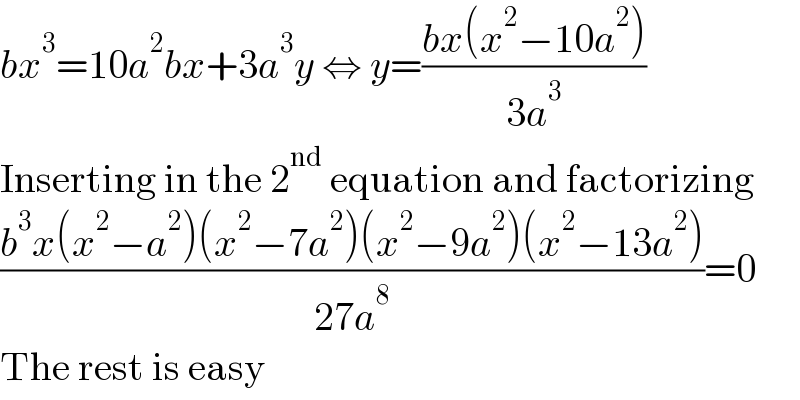
$${bx}^{\mathrm{3}} =\mathrm{10}{a}^{\mathrm{2}} {bx}+\mathrm{3}{a}^{\mathrm{3}} {y}\:\Leftrightarrow\:{y}=\frac{{bx}\left({x}^{\mathrm{2}} −\mathrm{10}{a}^{\mathrm{2}} \right)}{\mathrm{3}{a}^{\mathrm{3}} } \\ $$$$\mathrm{Inserting}\:\mathrm{in}\:\mathrm{the}\:\mathrm{2}^{\mathrm{nd}} \:\mathrm{equation}\:\mathrm{and}\:\mathrm{factorizing} \\ $$$$\frac{{b}^{\mathrm{3}} {x}\left({x}^{\mathrm{2}} −{a}^{\mathrm{2}} \right)\left({x}^{\mathrm{2}} −\mathrm{7}{a}^{\mathrm{2}} \right)\left({x}^{\mathrm{2}} −\mathrm{9}{a}^{\mathrm{2}} \right)\left({x}^{\mathrm{2}} −\mathrm{13}{a}^{\mathrm{2}} \right)}{\mathrm{27}{a}^{\mathrm{8}} }=\mathrm{0} \\ $$$$\mathrm{The}\:\mathrm{rest}\:\mathrm{is}\:\mathrm{easy} \\ $$
Commented by York12 last updated on 01/Jun/23

$${that}\:{would}\:{take}\:{a}\:{lot}\:{of}\:{time} \\ $$$$ \\ $$
Commented by York12 last updated on 01/Jun/23

$${watch}\:{this} \\ $$
Answered by a.lgnaoui last updated on 01/Jun/23
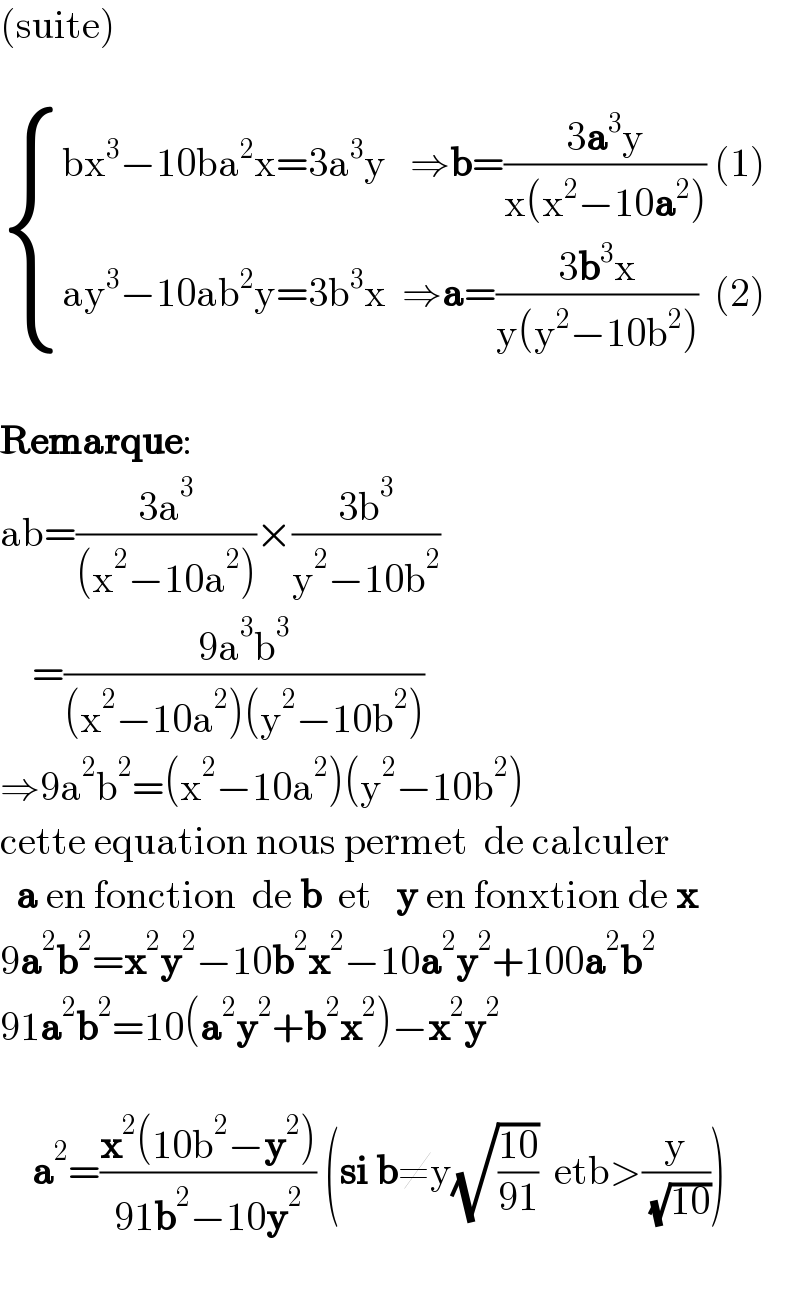
$$\left(\mathrm{suite}\right) \\ $$$$ \\ $$$$\begin{cases}{\mathrm{bx}^{\mathrm{3}} −\mathrm{10ba}^{\mathrm{2}} \mathrm{x}=\mathrm{3a}^{\mathrm{3}} \mathrm{y}\:\:\:\Rightarrow\boldsymbol{\mathrm{b}}=\frac{\mathrm{3}\boldsymbol{\mathrm{a}}^{\mathrm{3}} \mathrm{y}}{\mathrm{x}\left(\mathrm{x}^{\mathrm{2}} −\mathrm{10}\boldsymbol{\mathrm{a}}^{\mathrm{2}} \right)}\:\left(\mathrm{1}\right)}\\{\mathrm{ay}^{\mathrm{3}} −\mathrm{10ab}^{\mathrm{2}} \mathrm{y}=\mathrm{3b}^{\mathrm{3}} \mathrm{x}\:\:\Rightarrow\boldsymbol{\mathrm{a}}=\frac{\mathrm{3}\boldsymbol{\mathrm{b}}^{\mathrm{3}} \mathrm{x}}{\mathrm{y}\left(\mathrm{y}^{\mathrm{2}} −\mathrm{10b}^{\mathrm{2}} \right)}\:\:\left(\mathrm{2}\right)}\end{cases} \\ $$$$ \\ $$$$\boldsymbol{\mathrm{Remarque}}: \\ $$$$\mathrm{ab}=\frac{\mathrm{3a}^{\mathrm{3}} }{\left(\mathrm{x}^{\mathrm{2}} −\mathrm{10a}^{\mathrm{2}} \right)}×\frac{\mathrm{3b}^{\mathrm{3}} }{\mathrm{y}^{\mathrm{2}} −\mathrm{10b}^{\mathrm{2}} } \\ $$$$\:\:\:\:=\frac{\mathrm{9a}^{\mathrm{3}} \mathrm{b}^{\mathrm{3}} }{\left(\mathrm{x}^{\mathrm{2}} −\mathrm{10a}^{\mathrm{2}} \right)\left(\mathrm{y}^{\mathrm{2}} −\mathrm{10b}^{\mathrm{2}} \right)} \\ $$$$\Rightarrow\mathrm{9a}^{\mathrm{2}} \mathrm{b}^{\mathrm{2}} =\left(\mathrm{x}^{\mathrm{2}} −\mathrm{10a}^{\mathrm{2}} \right)\left(\mathrm{y}^{\mathrm{2}} −\mathrm{10b}^{\mathrm{2}} \right) \\ $$$$\mathrm{cette}\:\mathrm{equation}\:\mathrm{nous}\:\mathrm{permet}\:\:\mathrm{de}\:\mathrm{calculer} \\ $$$$\:\:\boldsymbol{\mathrm{a}}\:\mathrm{en}\:\mathrm{fonction}\:\:\mathrm{de}\:\boldsymbol{\mathrm{b}}\:\:\mathrm{et}\:\:\:\boldsymbol{\mathrm{y}}\:\mathrm{en}\:\mathrm{fonxtion}\:\mathrm{de}\:\boldsymbol{\mathrm{x}} \\ $$$$\mathrm{9}\boldsymbol{\mathrm{a}}^{\mathrm{2}} \boldsymbol{\mathrm{b}}^{\mathrm{2}} =\boldsymbol{\mathrm{x}}^{\mathrm{2}} \boldsymbol{\mathrm{y}}^{\mathrm{2}} −\mathrm{10}\boldsymbol{\mathrm{b}}^{\mathrm{2}} \boldsymbol{\mathrm{x}}^{\mathrm{2}} −\mathrm{10}\boldsymbol{\mathrm{a}}^{\mathrm{2}} \boldsymbol{\mathrm{y}}^{\mathrm{2}} +\mathrm{100}\boldsymbol{\mathrm{a}}^{\mathrm{2}} \boldsymbol{\mathrm{b}}^{\mathrm{2}} \\ $$$$\mathrm{91}\boldsymbol{\mathrm{a}}^{\mathrm{2}} \boldsymbol{\mathrm{b}}^{\mathrm{2}} =\mathrm{10}\left(\boldsymbol{\mathrm{a}}^{\mathrm{2}} \boldsymbol{\mathrm{y}}^{\mathrm{2}} +\boldsymbol{\mathrm{b}}^{\mathrm{2}} \boldsymbol{\mathrm{x}}^{\mathrm{2}} \right)−\boldsymbol{\mathrm{x}}^{\mathrm{2}} \boldsymbol{\mathrm{y}}^{\mathrm{2}} \\ $$$$ \\ $$$$\:\:\:\:\boldsymbol{\mathrm{a}}^{\mathrm{2}} =\frac{\boldsymbol{\mathrm{x}}^{\mathrm{2}} \left(\mathrm{10b}^{\mathrm{2}} −\boldsymbol{\mathrm{y}}^{\mathrm{2}} \right)}{\mathrm{91}\boldsymbol{\mathrm{b}}^{\mathrm{2}} −\mathrm{10}\boldsymbol{\mathrm{y}}^{\mathrm{2}} }\:\left(\boldsymbol{\mathrm{si}}\:\boldsymbol{\mathrm{b}}\neq\mathrm{y}\sqrt{\frac{\mathrm{10}}{\mathrm{91}}}\:\:\mathrm{etb}>\frac{\mathrm{y}}{\:\sqrt{\mathrm{10}}}\right)\: \\ $$$$ \\ $$
Answered by York12 last updated on 01/Jun/23
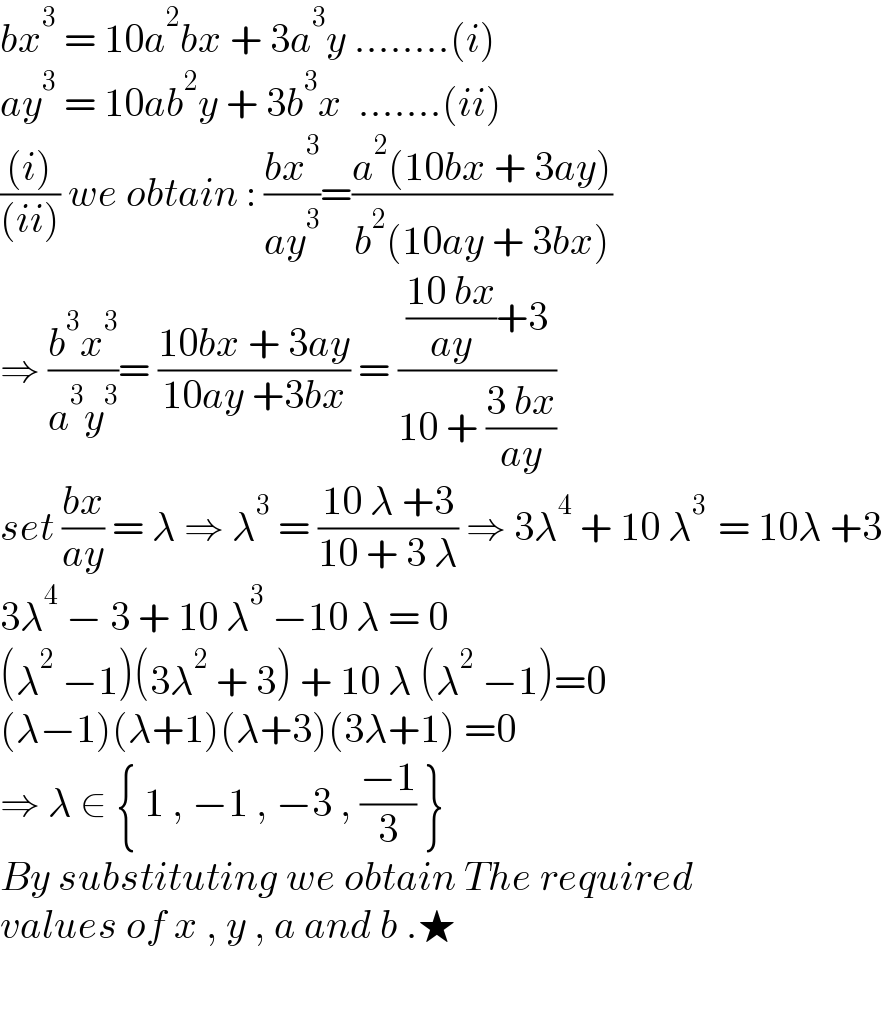
$${bx}^{\mathrm{3}} \:=\:\mathrm{10}{a}^{\mathrm{2}} {bx}\:+\:\mathrm{3}{a}^{\mathrm{3}} {y}\:........\left({i}\right) \\ $$$${ay}^{\mathrm{3}} \:=\:\mathrm{10}{ab}^{\mathrm{2}} {y}\:+\:\mathrm{3}{b}^{\mathrm{3}} {x}\:\:.......\left({ii}\right) \\ $$$$\frac{\left({i}\right)}{\left({ii}\right)}\:{we}\:{obtain}\::\:\frac{{bx}^{\mathrm{3}} }{{ay}^{\mathrm{3}} }=\frac{{a}^{\mathrm{2}} \left(\mathrm{10}{bx}\:+\:\mathrm{3}{ay}\right)}{{b}^{\mathrm{2}} \left(\mathrm{10}{ay}\:+\:\mathrm{3}{bx}\right)}\: \\ $$$$\Rightarrow\:\frac{{b}^{\mathrm{3}} {x}^{\mathrm{3}} }{{a}^{\mathrm{3}} {y}^{\mathrm{3}} }=\:\frac{\mathrm{10}{bx}\:+\:\mathrm{3}{ay}}{\mathrm{10}{ay}\:+\mathrm{3}{bx}}\:=\:\frac{\frac{\mathrm{10}\:{bx}}{{ay}}+\mathrm{3}}{\mathrm{10}\:+\:\frac{\mathrm{3}\:{bx}}{{ay}}}\: \\ $$$${set}\:\frac{{bx}}{{ay}}\:=\:\lambda\:\Rightarrow\:\lambda^{\mathrm{3}} \:=\:\frac{\mathrm{10}\:\lambda\:+\mathrm{3}}{\mathrm{10}\:+\:\mathrm{3}\:\lambda}\:\Rightarrow\:\mathrm{3}\lambda^{\mathrm{4}} \:+\:\mathrm{10}\:\lambda^{\mathrm{3}\:} \:=\:\mathrm{10}\lambda\:+\mathrm{3}\: \\ $$$$\mathrm{3}\lambda^{\mathrm{4}} \:−\:\mathrm{3}\:+\:\mathrm{10}\:\lambda^{\mathrm{3}} \:−\mathrm{10}\:\lambda\:=\:\mathrm{0} \\ $$$$\left(\lambda^{\mathrm{2}} \:−\mathrm{1}\right)\left(\mathrm{3}\lambda^{\mathrm{2}} \:+\:\mathrm{3}\right)\:+\:\mathrm{10}\:\lambda\:\left(\lambda^{\mathrm{2}} \:−\mathrm{1}\right)=\mathrm{0} \\ $$$$\left(\lambda−\mathrm{1}\right)\left(\lambda+\mathrm{1}\right)\left(\lambda+\mathrm{3}\right)\left(\mathrm{3}\lambda+\mathrm{1}\right)\:=\mathrm{0}\: \\ $$$$\Rightarrow\:\lambda\:\in\:\left\{\:\mathrm{1}\:,\:−\mathrm{1}\:,\:−\mathrm{3}\:,\:\frac{−\mathrm{1}}{\mathrm{3}}\:\right\} \\ $$$${By}\:{substituting}\:{we}\:{obtain}\:{The}\:{required}\: \\ $$$${values}\:{of}\:{x}\:,\:{y}\:,\:{a}\:{and}\:{b}\:.\bigstar \\ $$$$ \\ $$
Commented by Frix last updated on 01/Jun/23

$$\mathrm{To}\:\mathrm{divide}\:\mathrm{2}\:\mathrm{equations}\:\mathrm{is}\:\mathrm{not}\:\mathrm{allowed}: \\ $$$$\left(\mathrm{1}\right)\:\mathrm{6}=\mathrm{4}\:\mathrm{false} \\ $$$$\left(\mathrm{2}\right)\:\mathrm{3}=\mathrm{2}\:\mathrm{false} \\ $$$$\frac{\left(\mathrm{1}\right)}{\left(\mathrm{2}\right)}\:\frac{\mathrm{6}}{\mathrm{3}}=\frac{\mathrm{4}}{\mathrm{2}}\:\mathrm{true} \\ $$
Commented by ajfour last updated on 01/Jun/23

$${but}\:\:{if}\:\:\:\:\:\:\mathrm{6}=\mathrm{8}−\mathrm{2} \\ $$$$\:\:\:\:\:\:\:\:\:\:\:\:\:\:\:\:\:\:\:\:\mathrm{3}=\mathrm{13}−\mathrm{10} \\ $$$$\Rightarrow\:\:\mathrm{2}=\frac{\mathrm{6}}{\mathrm{3}}=\frac{\mathrm{8}−\mathrm{2}}{\mathrm{13}−\mathrm{10}}\:\:\:\:\:\left(..\right)! \\ $$
Commented by York12 last updated on 01/Jun/23

$${what}\:{you}\:{have}\:{written}\:{here}\:{is}\:{based}\:{on}\:{if}\: \\ $$$$\mathrm{6}=\mathrm{4}\:{is}\:{false}\: \\ $$$$\mathrm{3}=\mathrm{2}\:{is}\:{false}\: \\ $$$${but}\:{if}\:{the}\:{statement}\:{is}\:{true}\:{then}\:{we}\:{can}\:{always}\: \\ $$$${divide}\:{two}\:{equations}\: \\ $$
Commented by York12 last updated on 01/Jun/23

$${nothing}\:{extraordinary} \\ $$
Commented by York12 last updated on 01/Jun/23
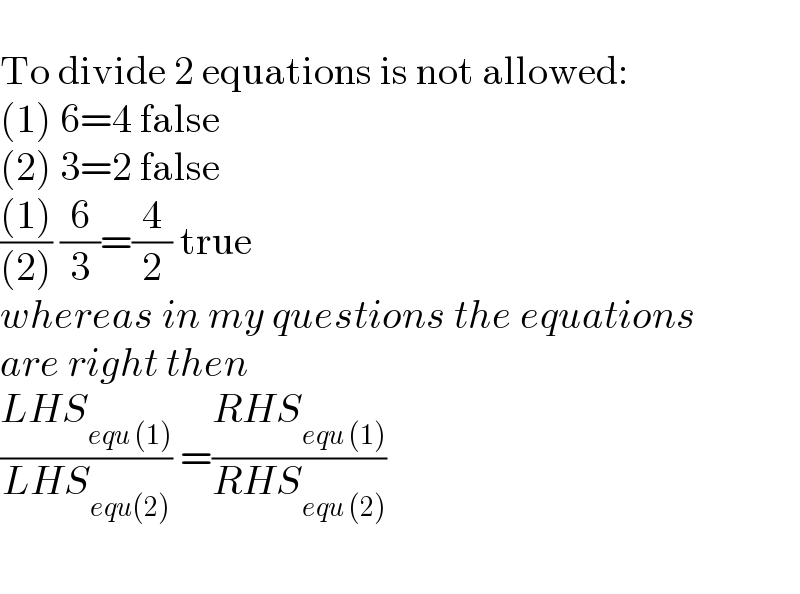
$$ \\ $$$$\mathrm{To}\:\mathrm{divide}\:\mathrm{2}\:\mathrm{equations}\:\mathrm{is}\:\mathrm{not}\:\mathrm{allowed}: \\ $$$$\left(\mathrm{1}\right)\:\mathrm{6}=\mathrm{4}\:\mathrm{false} \\ $$$$\left(\mathrm{2}\right)\:\mathrm{3}=\mathrm{2}\:\mathrm{false} \\ $$$$\frac{\left(\mathrm{1}\right)}{\left(\mathrm{2}\right)}\:\frac{\mathrm{6}}{\mathrm{3}}=\frac{\mathrm{4}}{\mathrm{2}}\:\mathrm{true} \\ $$$${whereas}\:{in}\:{my}\:{questions}\:{the}\:{equations}\: \\ $$$${are}\:{right}\:{then} \\ $$$$\frac{{LHS}_{{equ}\:\left(\mathrm{1}\right)} }{{LHS}_{{equ}\left(\mathrm{2}\right)} }\:=\frac{{RHS}_{{equ}\:\left(\mathrm{1}\right)} }{{RHS}_{{equ}\:\left(\mathrm{2}\right)} } \\ $$$$ \\ $$
Commented by Frix last updated on 01/Jun/23
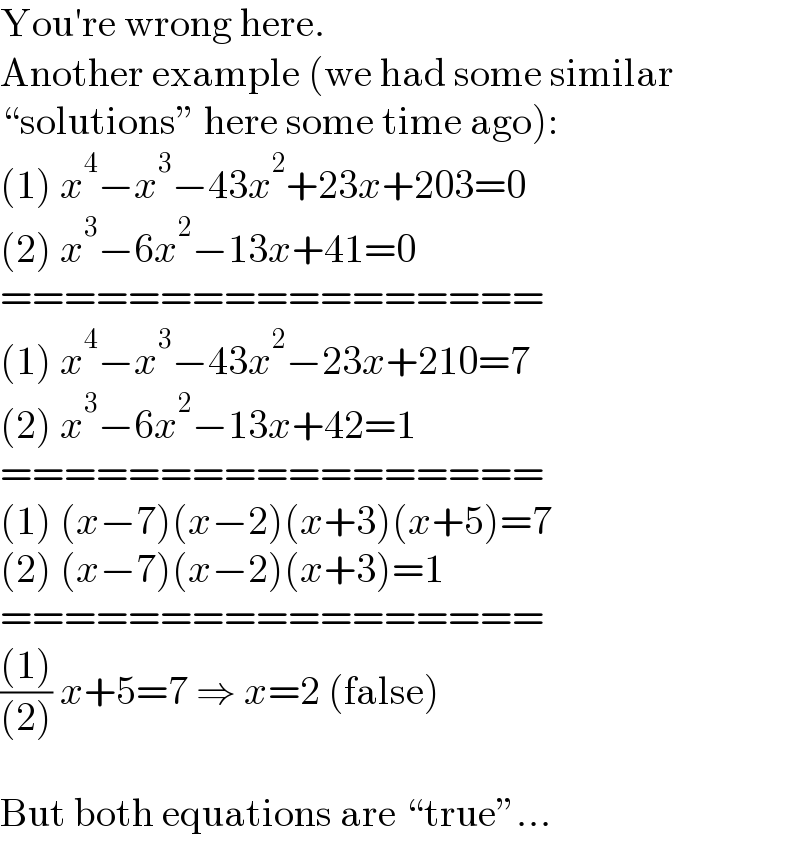
$$\mathrm{You}'\mathrm{re}\:\mathrm{wrong}\:\mathrm{here}. \\ $$$$\mathrm{Another}\:\mathrm{example}\:\left(\mathrm{we}\:\mathrm{had}\:\mathrm{some}\:\mathrm{similar}\right. \\ $$$$\left.``\mathrm{solutions}''\:\mathrm{here}\:\mathrm{some}\:\mathrm{time}\:\mathrm{ago}\right): \\ $$$$\left(\mathrm{1}\right)\:{x}^{\mathrm{4}} −{x}^{\mathrm{3}} −\mathrm{43}{x}^{\mathrm{2}} +\mathrm{23}{x}+\mathrm{203}=\mathrm{0} \\ $$$$\left(\mathrm{2}\right)\:{x}^{\mathrm{3}} −\mathrm{6}{x}^{\mathrm{2}} −\mathrm{13}{x}+\mathrm{41}=\mathrm{0} \\ $$$$================= \\ $$$$\left(\mathrm{1}\right)\:{x}^{\mathrm{4}} −{x}^{\mathrm{3}} −\mathrm{43}{x}^{\mathrm{2}} −\mathrm{23}{x}+\mathrm{210}=\mathrm{7} \\ $$$$\left(\mathrm{2}\right)\:{x}^{\mathrm{3}} −\mathrm{6}{x}^{\mathrm{2}} −\mathrm{13}{x}+\mathrm{42}=\mathrm{1} \\ $$$$================= \\ $$$$\left(\mathrm{1}\right)\:\left({x}−\mathrm{7}\right)\left({x}−\mathrm{2}\right)\left({x}+\mathrm{3}\right)\left({x}+\mathrm{5}\right)=\mathrm{7} \\ $$$$\left(\mathrm{2}\right)\:\left({x}−\mathrm{7}\right)\left({x}−\mathrm{2}\right)\left({x}+\mathrm{3}\right)=\mathrm{1} \\ $$$$================= \\ $$$$\frac{\left(\mathrm{1}\right)}{\left(\mathrm{2}\right)}\:{x}+\mathrm{5}=\mathrm{7}\:\Rightarrow\:{x}=\mathrm{2}\:\left(\mathrm{false}\right) \\ $$$$ \\ $$$$\mathrm{But}\:\mathrm{both}\:\mathrm{equations}\:\mathrm{are}\:``\mathrm{true}''... \\ $$
Commented by ajfour last updated on 02/Jun/23

$${coz}\:\:\:{if}\:{x}=\mathrm{2}\:\:\:{we}\:\:{shudnt}\:{have} \\ $$$${divided}\:{by}\:\left({x}−\mathrm{7}\right)\left({x}−\mathrm{2}\right)\left({x}+\mathrm{3}\right) \\ $$$${so}\:{it}\:{doesnt}\:\:{deceive}.\:{we}\:{know} \\ $$$${x}=\mathrm{2}\:\:{is}\:{then}\:{false}. \\ $$
Commented by York12 last updated on 02/Jun/23
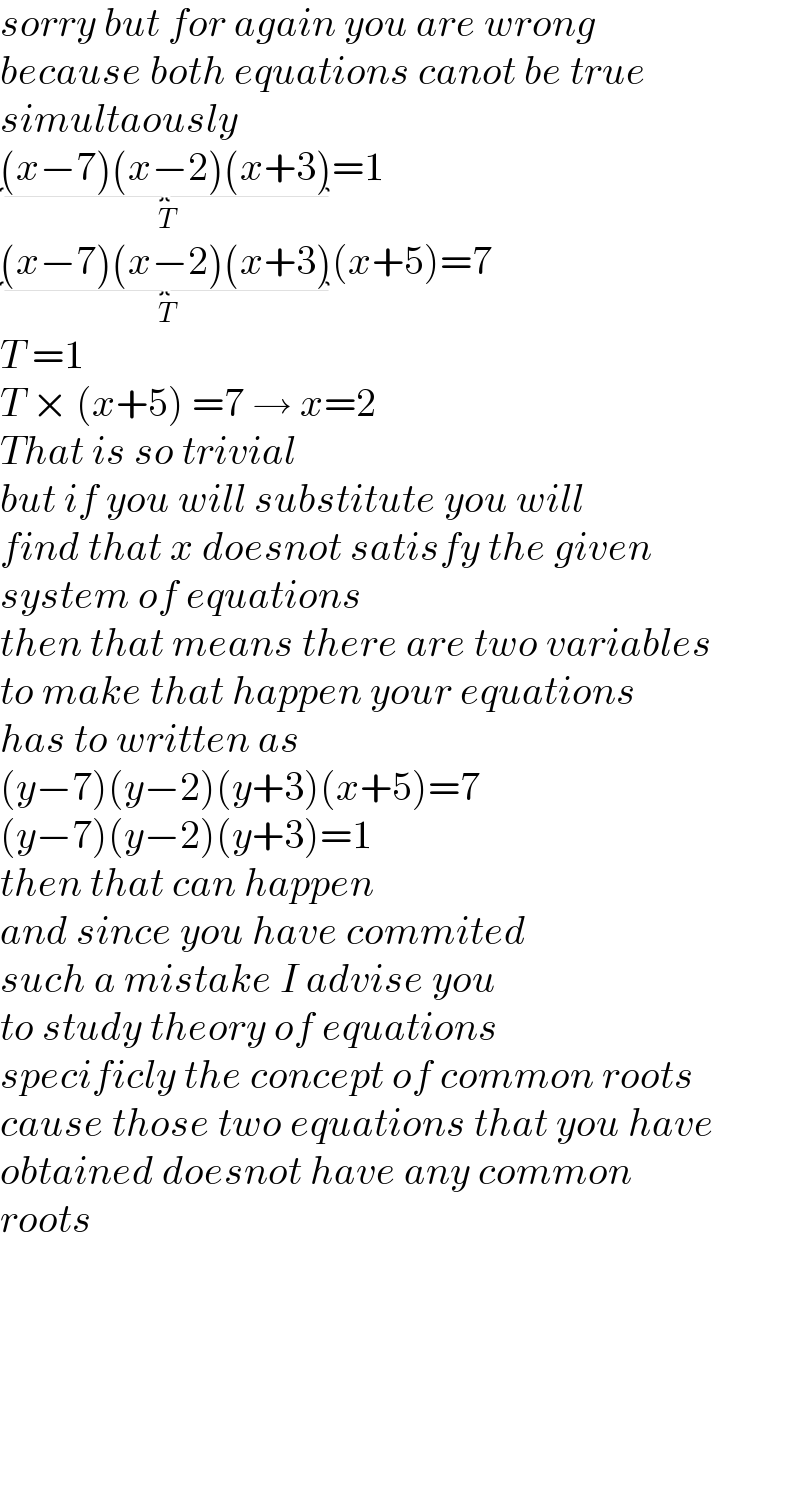
$${sorry}\:{but}\:{for}\:{again}\:{you}\:{are}\:{wrong}\: \\ $$$${because}\:{both}\:{equations}\:{canot}\:{be}\:{true}\: \\ $$$${simultaously} \\ $$$$\underset{{T}} {\underbrace{\left({x}−\mathrm{7}\right)\left({x}−\mathrm{2}\right)\left({x}+\mathrm{3}\right)}}=\mathrm{1} \\ $$$$\underset{{T}} {\underbrace{\left({x}−\mathrm{7}\right)\left({x}−\mathrm{2}\right)\left({x}+\mathrm{3}\right)}}\left({x}+\mathrm{5}\right)=\mathrm{7} \\ $$$${T}\:=\mathrm{1}\: \\ $$$${T}\:×\:\left({x}+\mathrm{5}\right)\:=\mathrm{7}\:\rightarrow\:{x}=\mathrm{2} \\ $$$${That}\:{is}\:{so}\:{trivial}\: \\ $$$${but}\:{if}\:{you}\:{will}\:{substitute}\:{you}\:{will}\: \\ $$$${find}\:{that}\:{x}\:{doesnot}\:{satisfy}\:{the}\:{given} \\ $$$${system}\:{of}\:{equations} \\ $$$${then}\:{that}\:{means}\:{there}\:{are}\:{two}\:{variables} \\ $$$${to}\:{make}\:{that}\:{happen}\:{your}\:{equations} \\ $$$${has}\:{to}\:{written}\:{as}\: \\ $$$$\left({y}−\mathrm{7}\right)\left({y}−\mathrm{2}\right)\left({y}+\mathrm{3}\right)\left({x}+\mathrm{5}\right)=\mathrm{7} \\ $$$$\left({y}−\mathrm{7}\right)\left({y}−\mathrm{2}\right)\left({y}+\mathrm{3}\right)=\mathrm{1} \\ $$$${then}\:{that}\:{can}\:{happen}\:\: \\ $$$${and}\:{since}\:{you}\:{have}\:{commited} \\ $$$${such}\:{a}\:{mistake}\:{I}\:{advise}\:{you} \\ $$$${to}\:{study}\:{theory}\:{of}\:{equations} \\ $$$${specificly}\:{the}\:{concept}\:{of}\:{common}\:{roots} \\ $$$${cause}\:{those}\:{two}\:{equations}\:{that}\:{you}\:{have}\: \\ $$$${obtained}\:{doesnot}\:{have}\:{any}\:{common}\: \\ $$$${roots} \\ $$$$ \\ $$$$ \\ $$$$ \\ $$$$ \\ $$
Commented by York12 last updated on 02/Jun/23
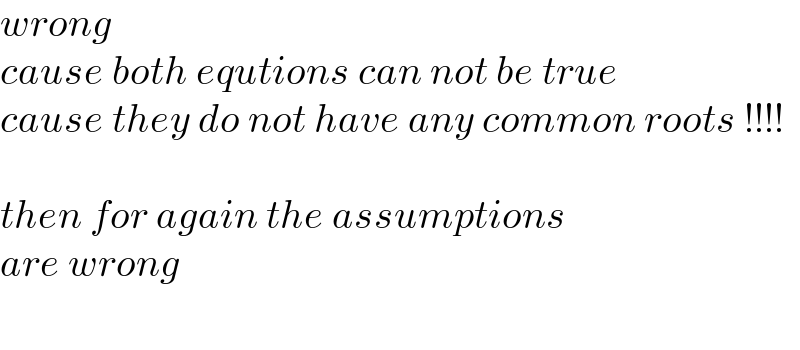
$${wrong} \\ $$$${cause}\:{both}\:{equtions}\:{can}\:{not}\:{be}\:{true}\: \\ $$$${cause}\:{they}\:{do}\:{not}\:{have}\:{any}\:{common}\:{roots}\:!!!! \\ $$$$ \\ $$$${then}\:{for}\:{again}\:{the}\:{assumptions} \\ $$$${are}\:{wrong}\: \\ $$$$ \\ $$
Commented by ajfour last updated on 02/Jun/23

$${who}\:{do}\:{u}\:{exactly}\:{tell}?{this}\:{all}.. \\ $$
Commented by York12 last updated on 02/Jun/23

$${to}\:{frix} \\ $$
Commented by ajfour last updated on 03/Jun/23
He's long past all this, we ll never get over!
Commented by Frix last updated on 08/Jun/23

$$\mathrm{I}'\mathrm{m}\:\mathrm{not}\:\mathrm{an}\:\mathrm{idiot}. \\ $$$$\mathrm{You}\:\mathrm{cannot}\:\mathrm{divide}\:\mathrm{2}\:\mathrm{equations}\:{before} \\ $$$$\mathrm{showing}\:\mathrm{that}\:\mathrm{this}\:\mathrm{division}\:\mathrm{is}\:\mathrm{legit}. \\ $$
Commented by York12 last updated on 13/Jun/23

$${no}\:{you}\:{can} \\ $$
